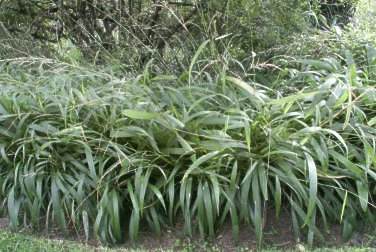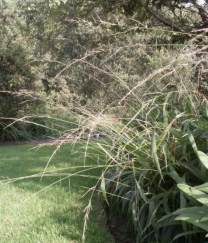Setaria megaphylla
Setaria megaphylla (Steud) Dur. & Schinz
Family: Poaceae
Common names: ribbon grass, broad-leafed bristle grass
Introduction
Setaria megaphylla may be found along rivers in low-lying areas or forests and in dense bushveld where there is plenty of moisture.

Description
Description
The broad-leafed bristle grass is a very tall, robust, tufted, perennial grass which is shade loving. This species may be confused with S. lindenburgiana, which has smaller leaves and inflorescences.
Distribution and habitat
Distribution description
It occurs in tropical and subtropical areas of Africa, America and India where there is high rainfall. In South Africa this species is mostly found in the summer rainfall areas in the savanna, grassland and forest biomes.
Derivation of name and historical aspects
History
The plant genus name Setaria is derived from the Latin word 'seta', meaning a bristle; and the species megaphylla from the Greek word 'mega' which means large and 'phylla' the leaf. This name describes the size of the leaves.
Uses
Use
This grass plays a major role in water purification as it absorbs excess nutrients from the water. It can also be used to stabilize unstable soil and prevent soil erosion. This is because it naturally colonises disturbed areas and is often found near water.
As a pasture grass it is good for grazing while still young when it is palatable with high leaf production.
Growing Setaria megaphylla
Grow

This species is very attractive and may be used as a garden ornamental, lining the borders of larger beds with its pendulous flowers. It can be planted in groups or clusters. The colour of the foliage is an attractive green and it remains green until late in the growing season. Good texture and colour combinations can be created by using this grass effectively in the garden. Its leaf texture also makes it an attractive choice for a container. Setaria megaphylla attracts birds to the garden as finches; canaries and other seed eating birds eat the seed. The leaves are also used by weavers to build their nests.
The best propagation technique of this type of perennial grass is by division as it forms large rootstocks and creeping stolons. Sexual propagation by means of seed can also be done, although in most instances large quantities of seed will not be available. Seed should be collected once the inflorescence has dried out. The dry inflorescences must be removed, placed in paper bags and shaken to release and catch the seeds. The best time to sow the seed is from December to February (midsummer).
References
- Bromilow, C. 1995. Problem plants of South Africa. Briza Publications. Cape Town.
- Gibbs Russell, G.E. 1990. Grasses of Southern Africa. National Botanic Gardens/ Botanical Research Institute Publishers. Pretoria.
- Van Oudtshoorn, F.P. 1999. Guide to Grasses of South Africa. Briza Publications. Cape Town.
- Van Oudtshoorn, F.P. 1992. Guide to Grasses of South Africa. Briza Publications. Cape Town. A. Hankey and L. Mashinini Witwatersrand National Botanic Garden April 2002
Credits
A. Hankey and L. Mashinini
Witwatersrand National Botanic Garden
April 2002
Plant Attributes:
Plant Type: Grass, Perennial
SA Distribution: Eastern Cape, Gauteng, KwaZulu-Natal, Limpopo, Mpumalanga, North West, Western Cape
Soil type: Sandy, Clay, Loam
Flowering season: Late Summer
PH: Neutral
Flower colour: Brown
Aspect: Full Sun, Shade, Morning Sun (Semi Shade), Afternoon Sun (Semi Shade)
Gardening skill: Easy
Special Features:
Horticultural zones











Rate this article
Article well written and informative
Rate this plant
Is this an interesting plant?
Login to add your Comment
Back to topNot registered yet? Click here to register.